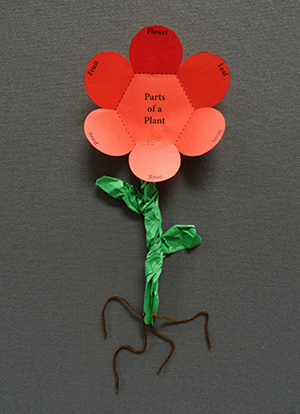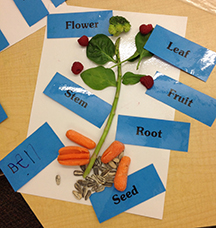Lesson Plan
Eating Plants
Grade Level
Purpose
Students identify the structure and function of six plant parts and classify fruits and vegetables according to which parts of the plants are edible. Grades K-2
Estimated Time
Materials Needed
Activity 1:
- Live strawberry plant or Parts of a Strawberry Plant Poster*
- Parts of a Plant Template 1 copied on colored paper, 1 per student
- Parts of a Plant Template 2 copied on white paper, 1 per student
- Green paper, 1 sheet per student
- Hole punch
- Brown yarn
*The Parts of a Strawberry Plant Poster is available for purchase from agclassroomstore.com.
Activity 2:
- Eating the Alphabet by Lois Ehlert
- Plant Part Chart*
- Fruit and Vegetable Cards
- Copy paper
- Hole punch
- Yarn
- 6 hula hoops
- Plant parts cards
*The Plant Part Chart Poster is available for purchase from agclassroomstore.com.
Activity 3:
- Carrots
- Asparagus
- Spinach
- Broccoli
- Strawberries
- Sunflower seeds
Vocabulary
flower: the part of a plant that contains reproductive parts and attracts pollinators
fruit: the part of a plant that develops from the flower and contains the seeds of the plant
leaves: part of a plant that uses energy from sunlight to carry out photosynthesis
root: the part of the plant that grows into the soil to anchor the plant and collect water and nutrients
seed: the part of a flowering plant that contains an embryo within its protective coat and a stored food supply
stem: the main supportive part of a plant; part of the transport system carrying water from the roots and food produced during photosynthesis to other parts of the plant
Background Agricultural Connections
The fruits and vegetables we eat come from parts of plants. Flowering plants have six main parts—roots, stems, leaves, flowers, fruits, and seeds. Each plant part serves a different function.
Roots act as anchors, holding a plant in place. They take up water and nutrients a plant needs from the soil. Roots can also store extra food for future use. Beets, carrots, radishes, and turnips are examples of edible roots.
Stems provide support for leaves, flowers, and fruit. Water, nutrients, and sugars travel to and from other parts of the plant through the stem. Asparagus is a stem that can be eaten. Potatoes, often mistakenly thought to be roots, are actually enlarged underground stems called tubers.
Leaves use energy from sunlight to carry out photosynthesis and make food for the plant. Edible leaves include arugula, cabbage, lettuce, mint, and spinach. Celery and rhubarb, commonly thought to be stems, are actually the part of a leaf called the leaf stalk or petiole.
Flowers contain the parts of the plant necessary for reproduction and play an important role in pollination. The shapes, colors, and scents of some flowers attract insect and animal pollinators. Following pollination, the fertilization process occurs within the flower. During fertilization, the ovary swells and seeds are produced. The flowers of some plants are edible. Broccoli and cauliflower are flowers that can be eaten.
Fruit is the part of the plant that contains seeds. This botanical definition includes many foods that are typically considered to be vegetables, such as cucumbers and green peppers, as well as more commonly recognized fruits, such as apples, oranges, bananas, and strawberries.
Seeds have three parts—the embryo, the endosperm, and the seed coat. The embryo grows into a new plant, the endosperm provides nutrients for the embryo, and the seed coat is the protective outer covering that encloses the embryo. With proper conditions, seeds will grow into new plants. Corn, wheat, peanuts, black beans, and sunflower seeds are examples of edible seeds.
It is important for students to understand that not all roots, stems, leaves, flowers, fruits, and seeds are edible and that some may even be harmful to humans if eaten. Stress the importance of not eating parts of wild plants unless a trusted adult is confident that the plant parts are safe to eat.
Engage
- Ask a student volunteer to make a sketch of a plant on the board. Encourage just a simple plant with a stem, leaves, roots, and a flower.
- To begin introducing the lesson and to assess prior knowledge, point to each part of the plant (roots, stem, leaves, flower) and ask the students if they know the name of that portion of the plant. Label each part as you discuss it. Inform your class that they will be learning more about each of these plant parts and which portions of the plant that we eat.
Explore and Explain
Activity 1: Plant Drama
- Show students the Parts of a Strawberry Plant poster or a live strawberry plant. Point out the roots, stems, leaves, flowers, fruit, and seeds of the plant.
- Using the information found in the Background Agricultural Connections as a guide, explain the functions of each plant part.
- Have the students act out each part of the plant.
- Roots: Sit on the ground, and pretend to anchor yourself in place to represent roots holding a plant in place. Make sucking noises to represent the water and nutrients being absorbed from the soil.
- Stems: Stand up straight to represent a stem supporting leaves, flowers, and fruit. Move your arms up your body from your feet to your head. This represents water, nutrients, and sugars moving through the stem.
- Leaves: Hold hands high in the air to represent leaves receiving energy from the sun to make food for the plant.
- Flowers: Make fancy poses to represent a flower attracting pollinators.
- Fruit: Pretend to hold a baby to represent the fruit protecting the seeds.
- Seeds: Roll into a ball on the ground and then slowly begin to stand up to represent a seed sprouting and growing into a new plant.
- Provide each student with a copy of Parts of a Plant Template 1. Have students cut out the flowers and fold up each petal on the dotted line.
- Twist green paper into the shape of a stem, and attach it to the back of the flower. Cut out leaf shapes, and attach them to the stem.
- Use a hole punch to make holes at the bottom of the stem, and tie brown yarn through the holes to represent roots.
- Using the strawberry plant or Parts of a Strawberry Plant poster as a reference, have the students attach each plant part from Parts of a Plant Template 2 onto the corresponding petal.

Activity 2: Edible Plant Parts
- Before this activity, make six plant parts cards: ROOT, STEM, LEAF, FLOWER, FRUIT, SEED.
- Read Eating the Alphabet by Lois Ehlert.
- Identify examples of roots, stems, leaves, flowers, fruit, and seeds from the book. Refer to the Plant Part Chart.
- Have students make fruit and vegetable “beanbags” using the Fruit and Vegetable Cards. Place each fruit and vegetable page on top of a piece of blank copy paper. Cut out the two pages together around the dashed lines for each fruit or vegetable.
- Punch holes around the outside edges of each fruit or vegetable card. Put crumpled paper between the two sheets of cut-out paper and use yarn to sew around the edge of each “beanbag.” Staples can be used as an alternative to sewing with yarn.
- Place six hula hoops on the floor. Lay plant part cards inside each hula hoop to distinguish them as roots, stems, leaves, flowers, fruit, or seeds.
- Separate the class into two teams. Each student will determine which edible plant part is shown on their beanbag and then try to throw it into the correct hula hoop.
- Roots: beets, carrots, radish
- Stems: kohlrabi, asparagus, potato
- Leaves: cabbage, spinach, lettuce
- Flowers: artichoke, broccoli, cauliflower
- Fruit: cherries, apple, grapes
- Seeds: sunflower seeds, corn, peanuts
- Each player can earn three points for their team. Two points can be earned for correctly identifying the edible part of the plant. An additional point can be earned if their beanbag lands in the correct hula hoop. The team with the most points wins.

Activity 3: Edible Masterpieces
- Ask families to donate samples of carrots, asparagus, spinach, broccoli, strawberries, and sunflower seeds. Wash all produce.
- Provide time for students to wash their hands.
- Instruct the students to use the fruits and vegetables to model the parts of a plant by creating edible plant art. Use carrots to make the roots of the plant, asparagus to make the stem of the plant, and so on.
- Label each part of the plant.
- Photograph the edible creations before inviting students to enjoy their artwork as a snack.

Evaluate
After conducting these activities, review and summarize the following key concepts:
- Plants have several parts. Each part has a purpose to keep the plant healthy and growing.
- We eat different parts of plants such as the stem, leaf, flower, fruit, root, and seeds.
- Farmers grow many types of plants to provide different kinds of fruits, vegetables, and grains for our diet.
Recommended Companion Resources
- A Fruit is a Suitcase for Seeds
- Berry Song
- Blue-Ribbon Radishes (Farm Friends)
- Botany on Your Plate: Investigating the Plants We Eat
- Carrots Grow Underground
- Dig In! Posters
- Eating the Alphabet
- From the Field to the Farmers Market
- Fruit Bowl
- Grandma Lena's Big Ol' Turnip
- Grow it Again
- Growing Microgreens
- Health and Nutrition from the Garden
- I Love Strawberries!
- Jr. Sprout – Funky Foods
- Jr. Sprout – Healthy Eating
- Las espinacas de Sylvia (Spanish Edition)
- Logan's Greenhouse
- Miss MacDonald has a Farm
- Oliver's Fruit Salad
- Parts of a Strawberry Plant Poster
- Plant Part Chart
- Strawberry Ag Mag
- Sweetpotato Ag Mag
- Sylvia's Spinach
- The Carrot Seed
- The First Strawberries: A Cherokee Story
- The Giant Carrot
- The Ugly Vegetables
- Tops & Bottoms
- Try It! How Frieda Caplan Changed the Way We Eat
- Up, Down, and Around
- Vegetables Flowchart
- Watercress
- What is a Fruit? What is a Vegetable? Bulletin Boards
- What's Inside a Flower?
Author
Organization
| We welcome your feedback! If you have a question about this lesson or would like to report a broken link, please send us an email. If you have used this lesson and are willing to share your experience, we will provide you with a coupon code for 10% off your next purchase at AgClassroomStore. |